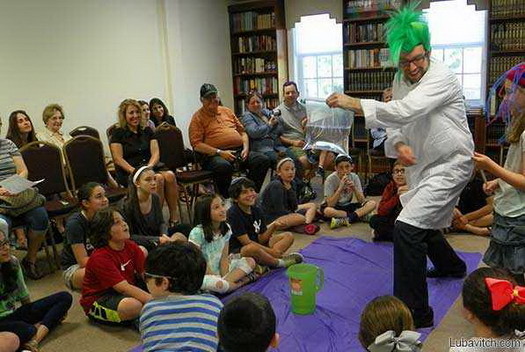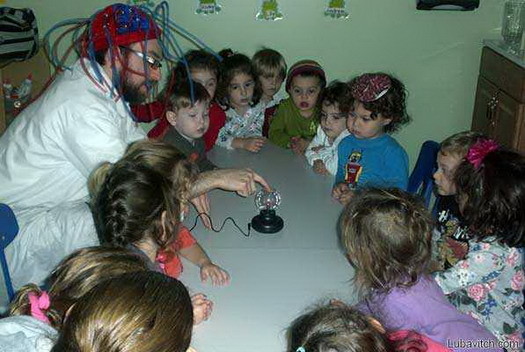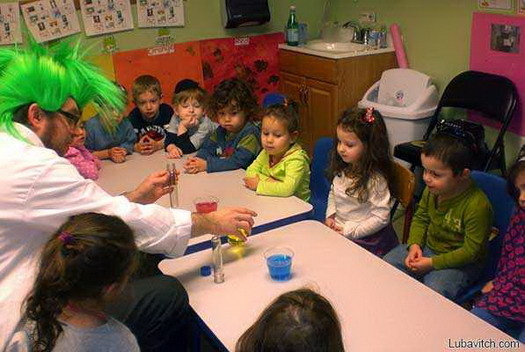
Learning Life Lessons From Wacky Science
As electric leaf blowers blow rolls of toilet paper, a delighted crowd of young children listen to Dr. Schnitzel derive Newton’s laws of motion, Jewish ideas, morals and observance. It is the ever popular world of mad science with a Jewish twist.
Rabbi Michoel Goldin, youth director of Chabad of Teaneck, New Jersey has been working with kids since he was a teenager. Dressed in a doctor’s coat and a green wig, Goldin says his passion for entertaining children has pushed his creativity “out of the box.”
As a counselor he’d reward his campers by performing juggling stunts or magic shows. He later joined up with a friend from his yeshiva days in Budapest where, known as the “Budapest Jugglers,” they ran programs for the children of the local Jewish community.
As director of Chabad of Brooklyn Heights’s Camp Gan Israel, he conducted weekly science experiments with the kids, employing them in his Judaic lessons. “The kids loved that more than anything else,” he says.
Goldin’s wacky sense of scientific adventure has captured the imagination of children and teens alike. To make a point about the human-G-d relationship, he demonstrates with five varieties of slime, each with its own texture: one bounces, one is very slimy, yet another is transparent. He shows the kids how slime is made and how its textures can be manipulated by adding one ingredient.
“This slime is not so clear,” he says holding up a dark slime, promising the kids some at the end of the session. “You can make a big wall out of it and no one will know what you do behind it.”
Just as they think they got it, the wacky scientist disrupts their satisfaction: “The truth is,” he tells them, “you can never hind behind anything. G-d sees everything you do. It’s as transparent as the clear slime.
“So let’s say you have a big bottle milk that you are carrying and it falls on the floor, or there is ketchup on the baby’s head. When mommy asks you who did it, what do you say?” he says in a singsong as the kids burst out in laughter.
Hiding behind the dark slime, he assures them, his face turning serious, will only make the situation sticker, like the very sticky slime. His lesson to this group of four year olds is clear as the transparent slime he’s showing them.
“When someone asks us a question, we always need to be very clear and always say the truth.”
Goldin, who now travels to do shows in the New York tri-state area, says that once he has the children’s attention, he finds that they are very receptive to his Jewish messages. “It’s important to do activities that the kids like, but there has to be a Jewish message and that is what I try to give the kids.”
Goldin searched Jewish texts and stories to come up with 70 ideas of how to connect mad science projects with Jewish ideas.
Aviva Edelstein is a mother of two children in Chabad of Teaneck’s summer camp. Her children, she says, loves Goldin. “The day that Dr. Schnitzel comes, that is their favorite day of the week.”
One day last week he brought an expanding bridge. After explaining to the three year olds why we need bridges, he called up one of the children to assist him in erecting his model bridge.
“You get to wear Dr. Shnitzel’s pajamas,” he tells the excited child. Everyone in the room cheers him on. As he slowly expands the bridge from one chair to the other, he asks the kids what holds the bridge from falling down.
“The streets and the sidewalk,” one child calls out.
“The street and the sidewalks are very important, but there are important pillars that hold the bridge.”
He then tells the children that there are three important pillars that the world stands upon.
“Do you know what they are?” he involves the children.
“Jelly beans.”
“Letting your parents sleep.”
“Making your mommy breakfast.”
Torah, prayers and doing good deeds, he explains, “are the pillars of the world.”
He shows them photos of bridges around the world and tells them to look out for bridges while they are driving around with their parents, and the next time he meets them they should tell him where they are.
“I think that a ‘scientist’ coming in and doing this, that in itself would be wonderful,” says Edelstein. “But the fact that he is also a rabbi, leading a life of Torah, and always teaching these dynamic science lessons, shows that there is a place for Torah in everything. Seeing him embody both worlds, my children could see how wonderful G-d’s world is while leading a good Jewish life.”
















